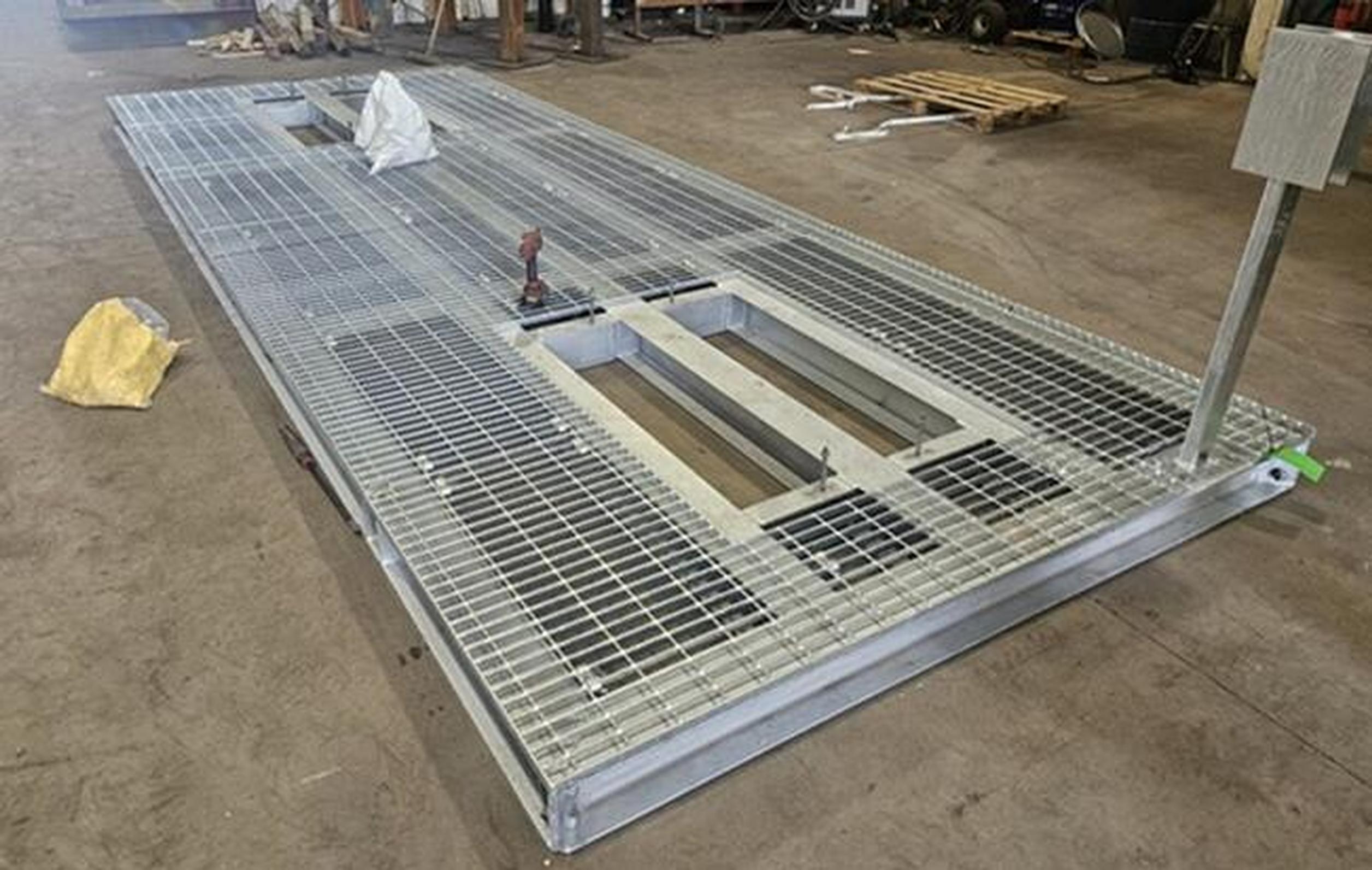

Multi-storey car park roof decks are increasingly being seen as a potential location for energy generation. Inner city car parks have seen a drop in use due to low emission zones, and top decks tend to be underutilised.
Top floors of car parks are therefore being considered as platforms for solar arrays. These arrays can sometimes come with heavy batteries and switchgear. However, care needs to be taken with installation methods and the placement of electrical plant.
This piece of advice is made in a report published by Collaborative Reporting for Safer Structures UK (CROSS-UK), an initiative of the Institution of Structural Engineers (IStructE), Institution of Civil Engineers (ICE) and Institution of Fire Engineers.
CROSS-UK shares information based on anonymised reports of concerns about real world structural issues.
A specialist firm offering ‘structural roof surveys’ associated with the renewables industry advised that two heavy batteries could be placed on a floor slab without load spreading or further assessment. They reached this conclusion by assuming that the load would be 1.5 kN/m2. However, the correct pressure was almost 14 kN/m2, an error made by the firm of a factor of nearly ten.
Key learning outcomes for clients and renewable companies:
Be aware that statutory approvals may be required prior to the installation of battery systems along with a structural assessment of the existing structure
The reporter's firm was asked, by chance, to review a design report that one of their clients had been given about placing storage batteries for a solar array on the upper level of a car park structure. The two batteries weighed a combined 2.9 tonnes and thus constituted a considerable concentrated load.
It was found that a specialist firm offering ‘structural roof surveys’ associated with the renewables industry had been previously appointed. This firm had reported that the batteries could be placed on the floor slab without load spreading or further assessment.
The firm had reached this conclusion by assuming that the load would be 1.5 kN/m2. Each battery weighed 1433kg and had a footprint of 1.1m by 0.93m. Given this, the correct pressure would be almost 14 kN/m2.The firm made an underestimation by a factor of almost ten.
There was also no advice or recommendations in the design report on how these heavy batteries should be temporarily stored or installed. According to the reporter, these two batteries could have been stored next to one another, further concentrating the load in a given area. Furthermore, they also could have been installed with lifting equipment (such as a small telehandler or fork truck) further exceeding the design-imposed load.
Very limited information was available on the existing slab for the car park roof, but given the load, span, and location the firm formed the view that the additional load could cause a problem.
Given the late discovery of the potential issue and the need for a speedy resolution, the reporter's firm assisted their client by designing a grillage system to spread the load of the two batteries.
Fabricating a grillage was deemed preferable to attempting to assess the slab for the extra load with limited information. The grillage was preassembled by the fabricator and lifted by crane onto the roof deck to its final location. The batteries were also lifted by crane from ground level directly to the grillage frame.
Multi-storey car park roof decks are being seen as a potential location for energy generation. Inner city car parks have seen a drop in use due to low emission zones, and drivers rarely want to park on the top deck when there is covered space available below. Therefore, top floors of car parks are being considered for ballasted solar arrays. These arrays can sometimes come with heavy batteries and switchgear, and so the reporter says that care needs to be taken with installation methods and the placement of plant.
Ground level car parks are also seeing a trend towards solar canopies for energy generation. The reporter is aware of some multi-storey car parks where solar canopies are being considered for the roof decks. Again, this requires careful consideration of existing structure and imposed loads, installation methods, and plant.
The reporter is concerned that the gross order of magnitude errors in assessing loading suggests that people are being employed in structural assessment work who lack the knowledge, skills, training and supervision to perform the task reliably. Competence of those offering technical advice is vital. New industries, such as renewable electricity generation give rise to new problems, additional demands for scarce technical resources, and associated commercial opportunities. In the view of the reporter, not everyone taking advantage of these new opportunities has the necessary skills and understanding.
This is a worrying set of circumstances connected to a growing industry. If the error had not been detected, it might have led to a failure if the slab was unable to support the load imposed by the batteries. It is fortunate that by chance the client had the design report reviewed by a third party. This highlights the benefit of checking designs and peer reviews.
While the slab may have had the capacity to support the batteries, it highlights that there may be a lack of quality management in place for the checking and approval of structural design assessments and calculations. There is also a potential risk that individuals lacking appropriate qualifications and experience may be undertaking the design work.
CROSS has recently received a number of reports on safety concerns in relation to the renewable energy industry.
Several Safety Reports have recently been published about photovoltaic (PV) panels being installed on roofs with inadequate assessment of the roof's capacity, including CROSS Safety Report 1414 - Concerns over domestic photovoltaic (PV) panel installations.
The expert panel is also aware of unsafe methods of working at height being used for such works. It is important that clients seek out competent advice for all phases of the work.
While the slab may have had the capacity to support the units, it is important to note that if a roof slab has a capacity given in kN/m2, that defines the capacity of the roof slab as a whole.
There is no essential link to a localised pressure under a small area (which can safely exceed to notional uniformly distributed load (UDL) capacity of the roof). Checking local capacity is a separate condition. Designers carrying out assessments need to be aware of adding units of high loads to existing structures and check the structural capacity both as a whole and as resistance to localised concentrated loads.
Works of this nature are subject to building regulations, but there is a concern that many of these works are being done without approval. Clients are advised that approval is necessary, and any questions or uncertainties should be directed to suitably qualified and experienced structural engineers for professional guidance.
It may also be worth considering whether using ‘structural’ in a company's name should require Institution of Structural Engineers (IStructE) registration or CEng association.
The panel agrees with the reporter that all stages of the works need to be considered for the design checks. There can be scenarios where temporary loads may be more onerous than permanent stage loads, and these always need to be considered and addressed.
CROSS-UK is an initiative of the Institution of Structural Engineers (IStructE), Institution of Civil Engineers (ICE) and Institution of Fire Engineers. CROSS-UK seeks to help professionals to make structures safer by publishing safety information based on the reports they receive and information in the public.

TransportXtra is part of Landor LINKS
© 2025 TransportXtra | Landor LINKS Ltd | All Rights Reserved
Subscriptions, Magazines & Online Access Enquires
[Frequently Asked Questions]
Email: subs.ltt@landor.co.uk | Tel: +44 (0) 20 7091 7959
Shop & Accounts Enquires
Email: accounts@landor.co.uk | Tel: +44 (0) 20 7091 7855
Advertising Sales & Recruitment Enquires
Email: daniel@landor.co.uk | Tel: +44 (0) 20 7091 7861
Events & Conference Enquires
Email: conferences@landor.co.uk | Tel: +44 (0) 20 7091 7865
Press Releases & Editorial Enquires
Email: info@transportxtra.com | Tel: +44 (0) 20 7091 7875
Privacy Policy | Terms and Conditions | Advertise
Web design london by Brainiac Media 2020